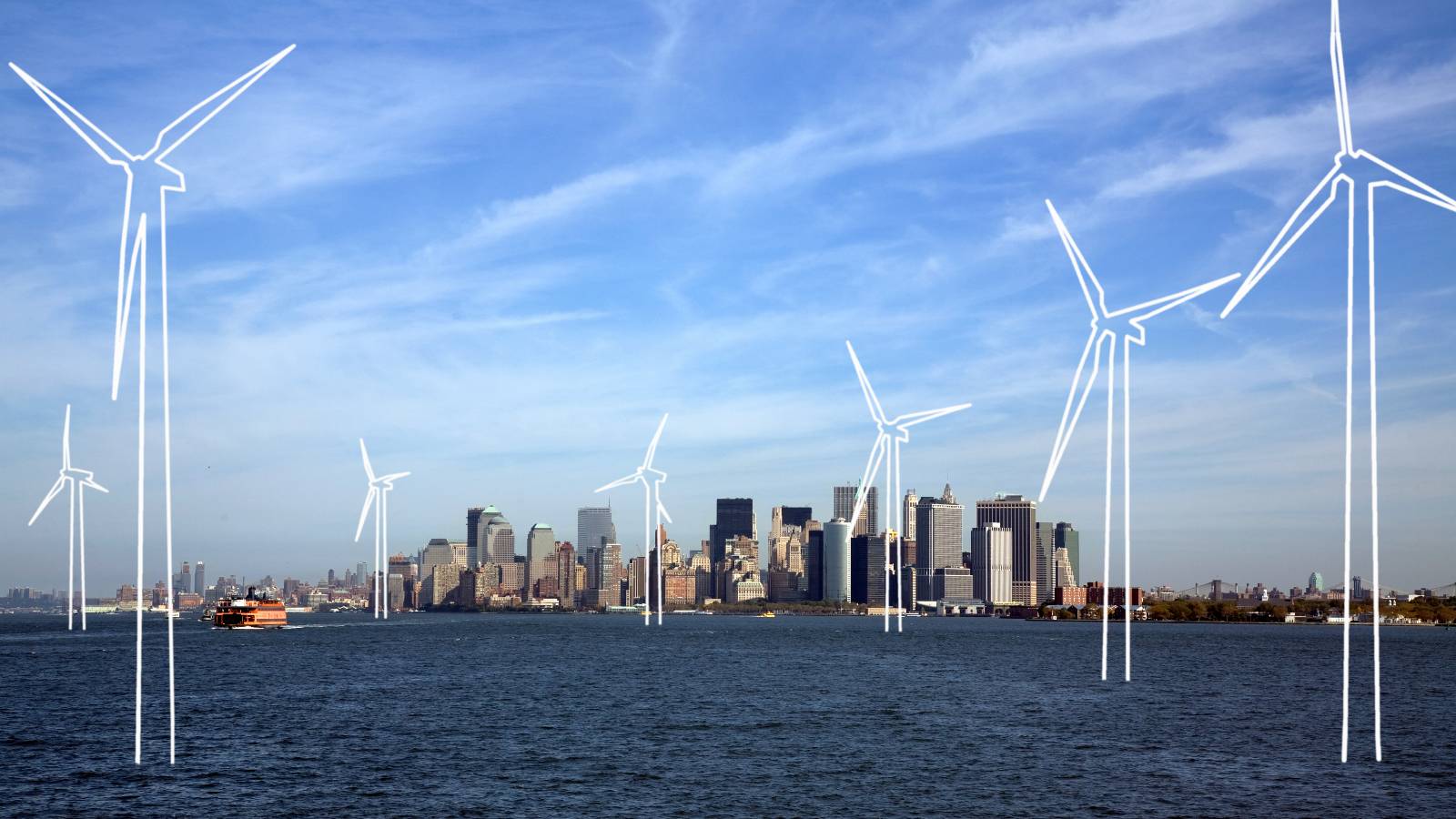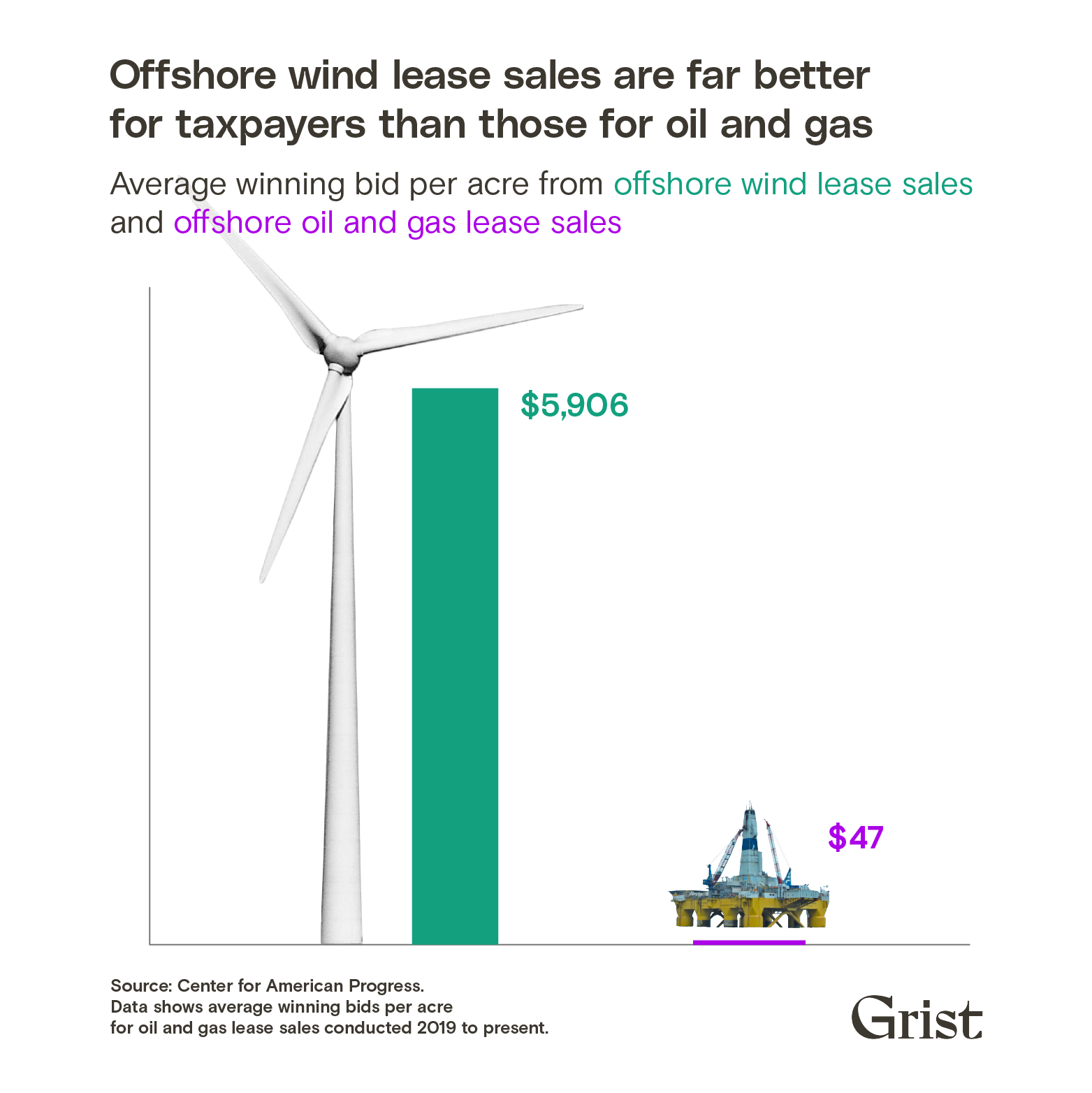A new report finds per-acre revenue from offshore wind blows oil and gas out of the water

Jessie Blaeser
Sep 23, 2022
GRIST
Not only is offshore wind power better for the planet compared to oil and gas, it’s also better for taxpayers. That’s according to a new analysis from the Center for American Progress, a nonpartisan policy research institute.
“Americans are getting significantly more return on investment from offshore wind energy lease sales than they are from oil and gas lease sales” per acre, said Michael Freeman, a conservation policy analyst for the Center and author of the report.
Offshore leases are essentially patches of publicly-owned waters rented out by the Bureau of Ocean Energy Management for energy production — a process governed by the National Environmental Policy Act, or NEPA. The money made from these leases goes to the U.S. Treasury Department, and, through public program funding, back into the pockets of taxpayers.
From 2019 to 2021, the average winning bid from offshore oil and gas lease sales was $47 per acre. By contrast, the average winning bid for a wind lease sale was 125 times higher — just over $5,900 per acre. And that number is likely to get even higher given the American wind industry is still in its relative infancy, said Jenny Rowland-Shea, the Director of Public Lands for the Center for American Progress.
With such a high return on investment, the new analysis suggests offshore wind leases could be a promising source of public revenue in comparison to oil and gas leases, while also reducing energy and fuel costs. Freeman said this money could be redistributed to taxpayers in the form of funding federal agencies or paying for health and education programs: “Expanding offshore wind energy is good for [taxpayers’] driving, for their wallet, for the air that they breathe.”

And of course, there are environmental benefits too. Energy produced by offshore wind does not result in the same climate consequences as offshore oil and gas energy production, which releases up to 87 metric tons of carbon dioxide per active acre in the Gulf of Mexico. That’s roughly the equivalent carbon pollution of 19 cars driven for one year. And according to the report, the social cost of carbon emissions per acre for oil leases is over $16,000 and roughly $2,800 for natural gas leases. Meanwhile, the social cost of carbon emissions from offshore wind power is “essentially nil” per acre, Freeman said. “Clean energy really is clean.”
Offshore wind power has a long way to go before it can come close to the scale of its oil and gas equivalent, but the U.S. has announced big plans for the industry. Early in 2021, the Biden administration set the goal of producing 30 gigawatts of offshore wind power by 2030, or enough to power 10 million homes. This August, Biden signed the Inflation Reduction Act into law, which tied the Bureau of Ocean Energy Management’s ability to issue offshore wind leases to oil and gas leasing, effectively connecting the expansion of offshore wind to expansion of offshore oil and gas energy production.
Prior to the Inflation Reduction Act, the Bureau of Ocean Energy Management had only sold two offshore wind leases to U.S. operators, which contribute less than 1 percent of the energy required to reach the 30-gigawatt goal.
While energy analysts say offshore wind lease sales create greater return on investment for the government and produce more energy per acre compared to offshore oil and gas, the latter is, at least for the present time, more cost effective. That’s because of the high start-up costs associated with the relatively new offshore wind industry. Nevertheless, Freedman said he expects offshore leases to shift away from oil and gas in the future.
The report shows that offshore wind leasing is a valid way to harness ocean energy resources, Rowland-Shea said, and at a crucial time. “What’s at stake is acting on the climate emergency and our transition to a clean energy economy.”

Wind and solar energy are already the cheapest options for new power projects.
Published 22h ago
Making the switch from dirty fossil fuels to cleaner renewable energy could save the world as much as $12 trillion (R220 trillion), a recent Oxford University study says.
The report said it was wrong and pessimistic to claim that moving quickly towards cleaner energy sources was expensive.
Story continues below Advertisement
This comes as gas prices in Europe have soared on increased concerns over energy supplies, much of which come from Russia – now widely seen as a pariah state.
“Rapidly decarbonising the global energy system is critical for addressing climate change, but concerns about costs have been a barrier to implementation. Most energy-economy models have historically underestimated deployment rates for renewable energy technologies and overestimated their costs,” the researchers said.
The constantly decreasing cost of renewables is something that cannot be ignored any longer because it makes choosing green energy simply a good economic decision, the researchers said.
"Even if you're a climate denier, you should be on board with what we're advocating," Professor Doyne Farmer from the Institute for New Economic Thinking at the Oxford Martin School said.
"Our central conclusion is that we should go full-speed ahead with the green-energy transition because it's going to save us money," he said.
Researchers used historic price data for both renewables and fossil fuels to construct a model on how these are likely to change in the future.

Fossil fuel data goes back more than a century from 2020 and shows that, after accounting for inflation and market volatility, the prices of fossil fuels haven't changed much.
Researchers admitted that, owing to the widespread use of renewables being relatively recent, there isn’t as much data available as there is for fossil fuels, but over time the continual improvements in technology have meant the cost of solar and wind power have fallen rapidly, at a rate approaching 10% a year.
Researchers used a "probabilistic" modelling method to determine that the price of renewables will continue to fall. This made use of data on how massive investment and economies of scale have made other similar technologies cheaper.
Story continues below Advertisement
"Our latest research shows scaling up key green technologies will continue to drive their costs down, and the faster we go, the more we will save," said Dr Rupert Way from the Smith School of Enterprise and the Environment, the report's lead author.
Although wind and solar energy are already the cheapest options for new power projects, questions remain over how to best store power and balance the grid when changes in the weather lead to a fall in renewable output.
In 2019, Philip Hammond, then the Chancellor of the Exchequer, wrote to the then British prime minister stating that the cost of reaching net-zero greenhouse gas emissions by 2050 in the UK would be over £1 trillion. This report says the likely costs have been overestimated and have deterred investment.
The research has been published in the journal Joule and is a collaboration between the Institute for New Economic Thinking at the Oxford Martin School, the Oxford Martin Programme on the Post-Carbon Transition, the Smith School of Enterprise & Environment at the University of Oxford, and SoDa Labs at Monash University.





:format(jpeg)/cloudfront-us-east-1.images.arcpublishing.com/tgam/XANSYE3QSNIBTLGQON3F4K5OAE.jpg)


